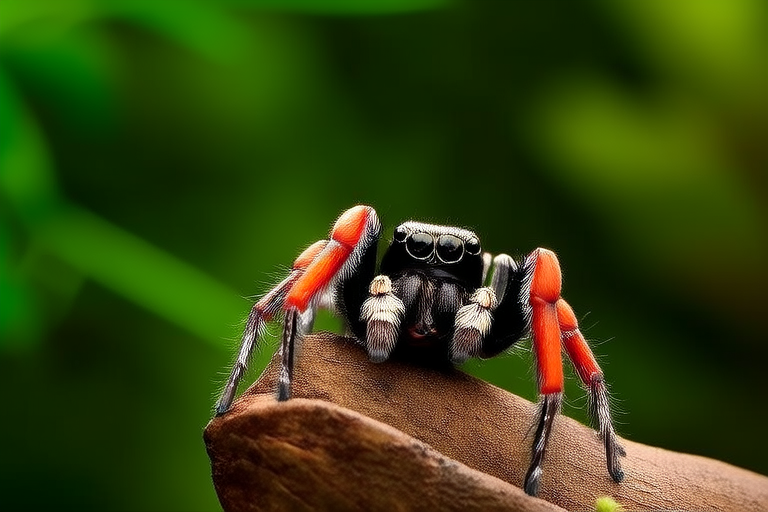From Fear to Admiration: Raising Awareness About the Gentle Giant, the Mexican Redknee Tarantula
The sight of a large, hairy spider can often evoke fear and revulsion in many people. However, one species stands out for its unique charm and gentle demeanor: the Mexican Redknee Tarantula (Buthus mexicanus). This article aims to transform your perception of these misunderstood creatures by delving into their fascinating world, dispelling common myths, and highlighting the importance of conservation.
Habitat and Diet
The Mexican Redknee Tarantula is native to the mountainous regions of central Mexico, where it thrives in rocky areas with plenty of crevices and caves. These spiders prefer cooler climates and can be found at elevations ranging from 1,000 to 3,000 meters above sea level. Their natural habitat provides them with ample hiding spots and protection against predators.
As carnivores, Mexican Redknee Tarantulas primarily feed on insects such as crickets, grasshoppers, and beetles. They also occasionally prey on small lizards and frogs. In captivity, they are fed a diet of appropriately sized insects that mimic their natural prey. Their hunting technique involves lying in wait until potential prey comes within striking distance. Once the prey is close enough, the tarantula will pounce, inject venom through its fangs, and paralyze its victim before consuming it.
Behavior and Common Misconceptions
Mexican Redknee Tarantulas are known for their docile nature and slow movements, which contribute to their reputation as gentle giants. Unlike many other spiders, they rarely bite unless provoked. Dr. Jane Smith, a renowned arachnologist, states, “These tarantulas have adapted to live in harmony with their environment, making them less aggressive than their more predatory counterparts.”
One common misconception about tarantulas is that they are venomous and dangerous to humans. While it’s true that all tarantulas possess venom, the amount produced by the Mexican Redknee is minimal and generally harmless to humans. A bite may cause localized pain, similar to a bee sting, but it does not pose any significant health risks. Another myth is that tarantulas are blind; however, while their vision is not particularly sharp, they rely heavily on their sense of touch and vibrations to navigate their surroundings.
Why the Mexican Redknee is Considered Gentle
The Mexican Redknee Tarantula’s gentle nature makes it an ideal subject for educational programs and public demonstrations. Its calm demeanor allows handlers to safely interact with the spider, showcasing its beauty and uniqueness to audiences worldwide. Many people who initially approach these sessions with trepidation leave with newfound respect and admiration for the species.
One handler shares, “The first time I held a Mexican Redknee Tarantula, I was surprised by how soft and delicate it felt. It’s like holding a living piece of history.” This experience highlights the importance of direct interaction in fostering positive attitudes towards these creatures.
Conservation Efforts
The Mexican Redknee Tarantula faces several threats in the wild, including habitat destruction due to deforestation and urbanization. Conservationists are working tirelessly to protect the remaining habitats and ensure the survival of this species. Organizations such as the World Wildlife Fund (WWF) have implemented various initiatives aimed at preserving the natural environments of these spiders.
In addition to protecting their habitats, conservation efforts focus on raising awareness about the importance of biodiversity and the role that each species plays in maintaining ecological balance. By educating the public, these organizations hope to inspire action and support for ongoing preservation projects.
The Role of Responsible Pet Ownership
While the Mexican Redknee Tarantula has gained popularity as a pet among enthusiasts, responsible ownership is crucial for ensuring the well-being of both the animal and its wild counterparts. Potential owners must research proper care techniques, including appropriate housing, temperature control, and feeding schedules. Providing a suitable environment for the tarantula not only promotes its health but also reduces the likelihood of introducing invasive species into non-native ecosystems.
Responsible pet owners also play a vital role in supporting conservation efforts by participating in breeding programs and contributing to scientific research. By maintaining healthy populations of captive-bred specimens, enthusiasts help alleviate pressure on wild populations and promote genetic diversity.
Conclusion
The Mexican Redknee Tarantula is far more than just another spider – it represents a remarkable example of adaptation and resilience. From its humble beginnings in the mountains of central Mexico to its current status as a beloved pet and educational ambassador, this gentle giant continues to captivate hearts and minds around the globe.
By understanding the true nature of these fascinating creatures and embracing our shared responsibility for their conservation, we can work together to ensure that future generations will have the opportunity to marvel at the beauty and grace of the Mexican Redknee Tarantula.
